The Origin of the Legend of Kusu
My initial exposure to local legends began in the early 1990s, drawn by stories woven into the Social Studies primary school textbook. It was a fascination that involved compiling variations into my notebook during regular visits to the school library, which led to an unexpected librarian appointment by the supervising teacher1.
Despite retaining a collector’s instinct, I have outgrown romanticism and now focus on their merit as a structural and evolving form of storytelling. The shift in interest stems from recognising that not all narratives are arbitrary, but can also be reflections of collective fear and historical events that shape imagination. The legend of Kusu follows the same trajectory.
The Soul of the Island
Most Singaporeans know the legend features a colossal shelled reptile2, but this wasn’t always the case. In 1929, Straits Times reported that a Peranakan man from Joo Chiat iconised a tremendously large snake he encountered on Kusu as the soul of the island3. This isn’t unusual, as similar lore arose at the former location of the German Girl Shrine and the now-demolished Keramat Kallang due to single unexpected encounters.
Symbolism of snakes in traditional Malay cosmology differs from the Chinese, often framing them as harbingers of fear and misfortune, shaped by Hindu empires that once dominated Southeast Asia. Chinese traditions offer a contrasting interpretation, attributing traits like wisdom, mystery, sensuality, and introspection, while also symbolising them as agents of transformation, immortality, and cyclical forces.
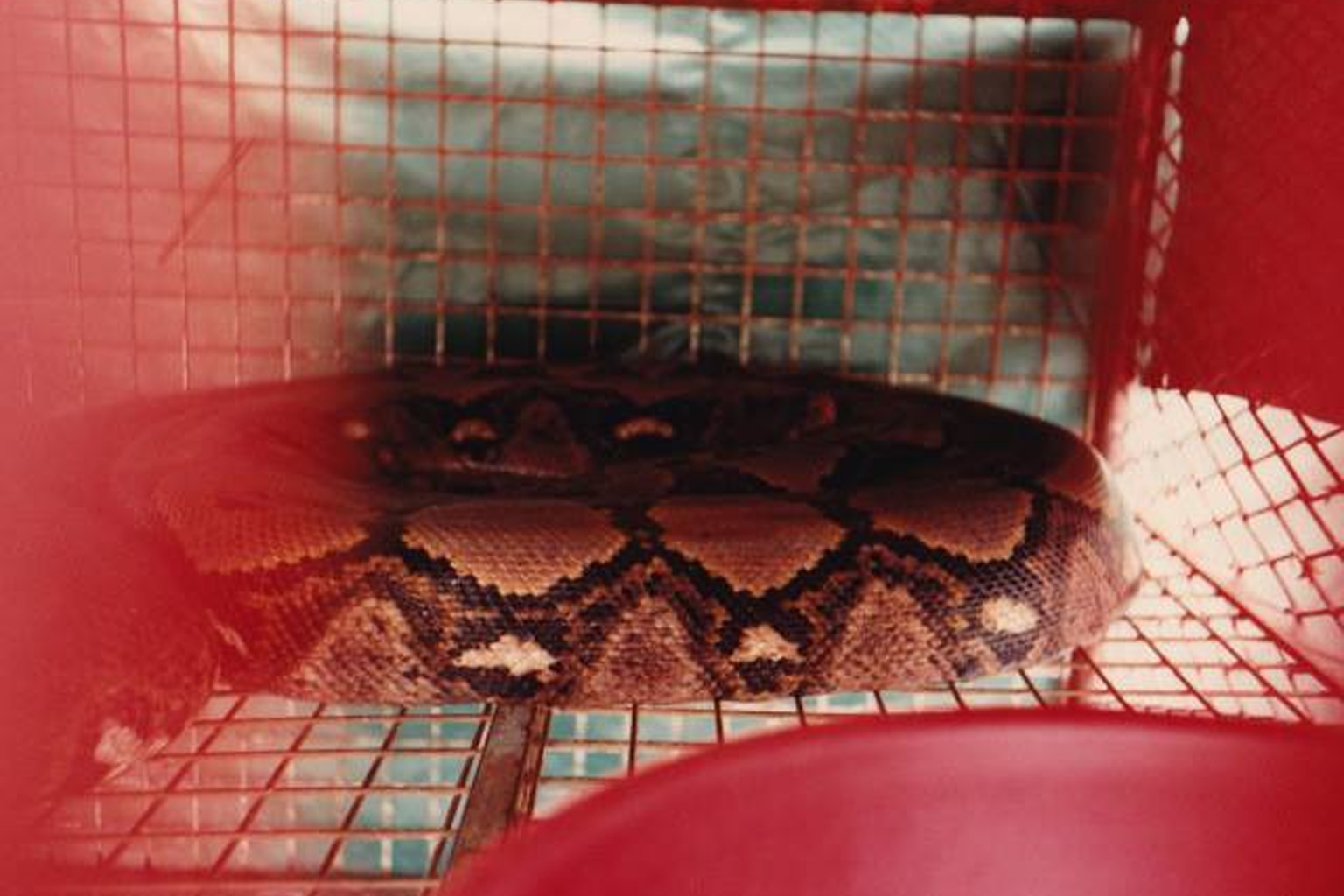
In Singapore between the 1970s and 1990s, pythons were seen in red cages at Chinese shrines across Bugis Street4, Desker Road, Keong Saik Road, and Sungei Road Market5, including inside a temple at Kinta Road6, all serving as spiritual sentinels. While such practices have since been outlawed in Singapore, similar practices continue at the Snake Temple in Penang, Malaysia.
Going back to the intial topic, the 1932 Straits Times article Chinese Topics In Malaya7 marked the decline of the snake narrative and may be regarded as the genesis of the modern Kusu legend8, which later matured into a shipwreck tale of two fishermen in a storm, a colossal shelled reptile that save them by turning into an island, and in some iterations, sailors who accompany or replace them.
Disasters at Sea
While the motif of a shelled reptile is symbolic, the theme of shipwrecks and fishermen reflects real conditions of the past. Disasters at sea common due to poor navigation tools, fragile wooden hulls, no weather forecasting, piracy, regional conflicts, a lack of rescue systems, and natural hazards like reefs and rocky coasts. Meanwhile, the coasts of Singapore were abundant with fishing villages, where local subsistence fishermen were less affected by these threats due to their familiarity with seasonal patterns and tidal behaviour, and would usually stay nearshore to avoid unnecessary risks. This differs from those whose livelihood depended on the sea, as they went out at night and returned by dawn with daily fresh catch for designated wet markets.
If the legend of Kusu were entirely based on a true event, a likely scenario is that they were local fishermen caught in a sudden storm while fishing at night. However, the legend contradicts reality as it undermines the fishermen’s familiarity with the waters and surrounding terrain by portraying a known island as a giant shelled reptile.
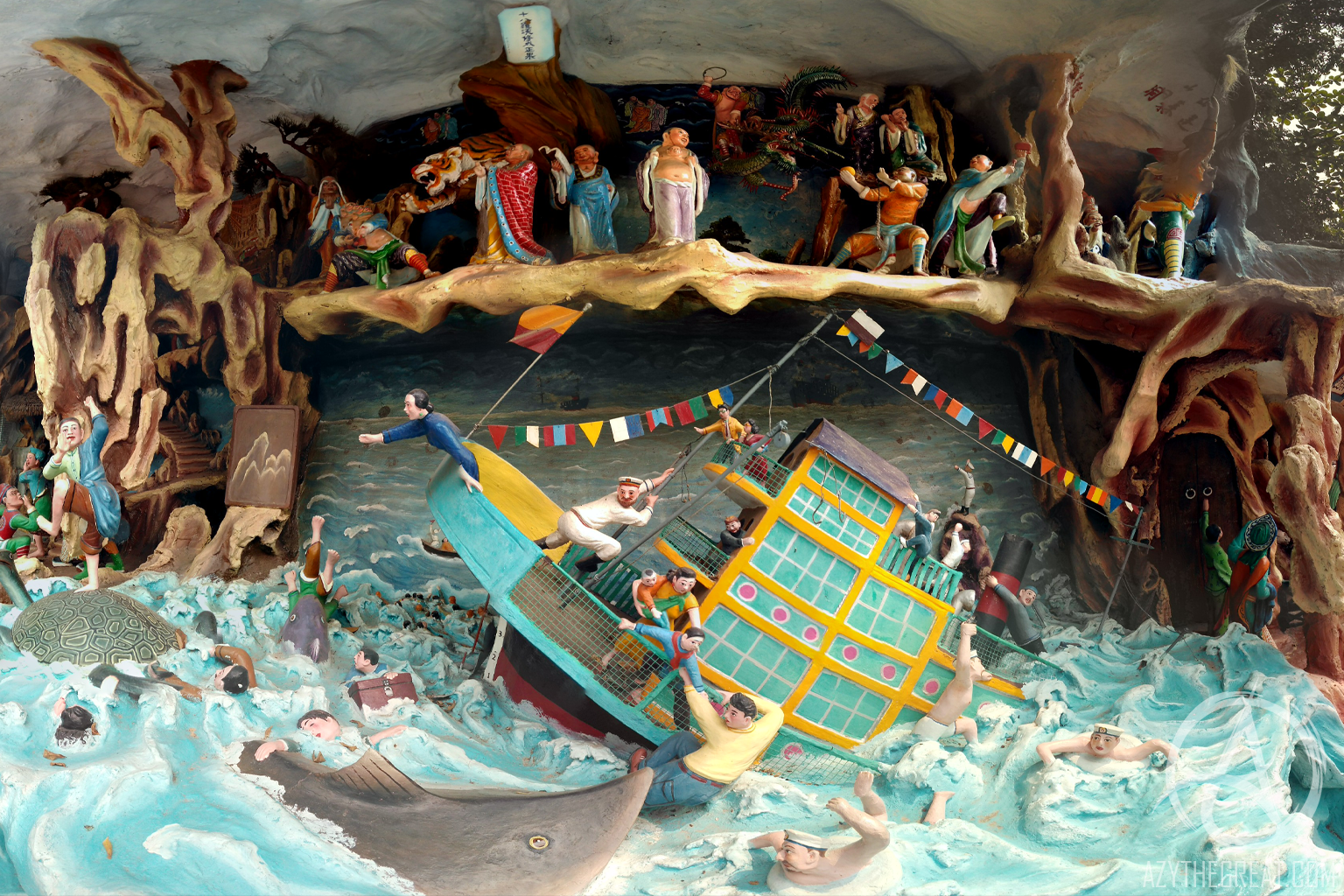
The motif of fishermen being rescued by a giant shelled reptile can be found in other folk tales from Northeast Asia, such as the third-century Liùdù Jíjīng (六度集經, Sutra of the Six Perfections), which includes a story about a turtle saving a human, reflecting Buddhist teachings on compassion, sacrifice, and karmic return. A similar motif appears in the Japanese folktale Urashima Tarō. And finally, a panel at Haw Par Villa yet again depicts a turtle rescuing a man named Wang Qing. Given its similarity to other folktales, the giant shelled-reptile in the Kusu legend is likely a local adaptation rooted in Chinese folklore.
The motif of the fishermen in the legend being Malay and Chinese respectively originated from the 1932 Straits Times article mentioned earlier. While the two ethnicities are often viewed as a symbolic representation of racial harmony, this interpretation is relatively modern, shaped by present-day Singapore’s ideology of multiculturalism.
A more plausible anthropological reading is that the two figures reflect the syncretism between the Malay belief in keramat and the Chinese belief in Tu Di Gong, which gave rise to the local Na Du Gong9, who has a shrine on Kusu and bears a Malay name, Dato Syed Abdul Rahman.
How did Keramat Kusu get there?
Why would Kusu have any significance in the first place? And why was there a shrine on this specific island instead of others around? Jong10 and Kusu both have hills and rocky reefs, but why this one, while Jong remains deserted?
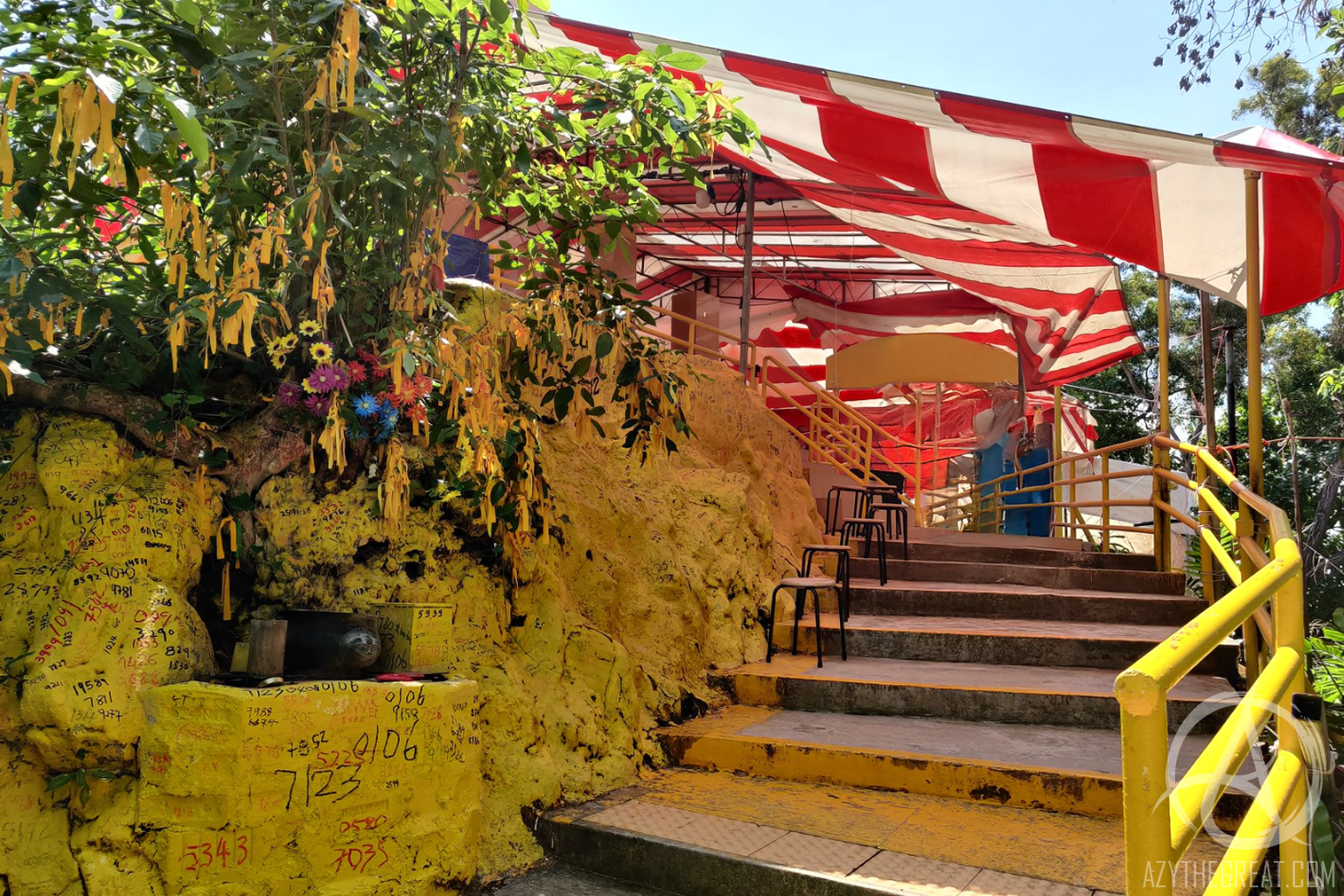
These were the questions I posed during a field survey on Kusu in 2022. My current take is that Kusu likely once had a fresh water source for seafarers in the past, and this is supported by similar sites across Singapore, Malaysia, and Indonesia. Even the ancient port of Tumasik (present-day Singapore River) had a spring on the nearby hill now known as Fort Canning11.
In Southeast Asia context, islands without freshwater were usually bypassed unless they offered trade, shelter, or strategic value. Freshwater was a prerequisite for a pit stop, and pit stops had to exist before shrines like Keramat Kusu12 or the Tua Pek Kong Temple could be established. These worship sites could only be built where people regularly stopped to stock up on freshwater and pray for safe passage at sea before continuing their journey.
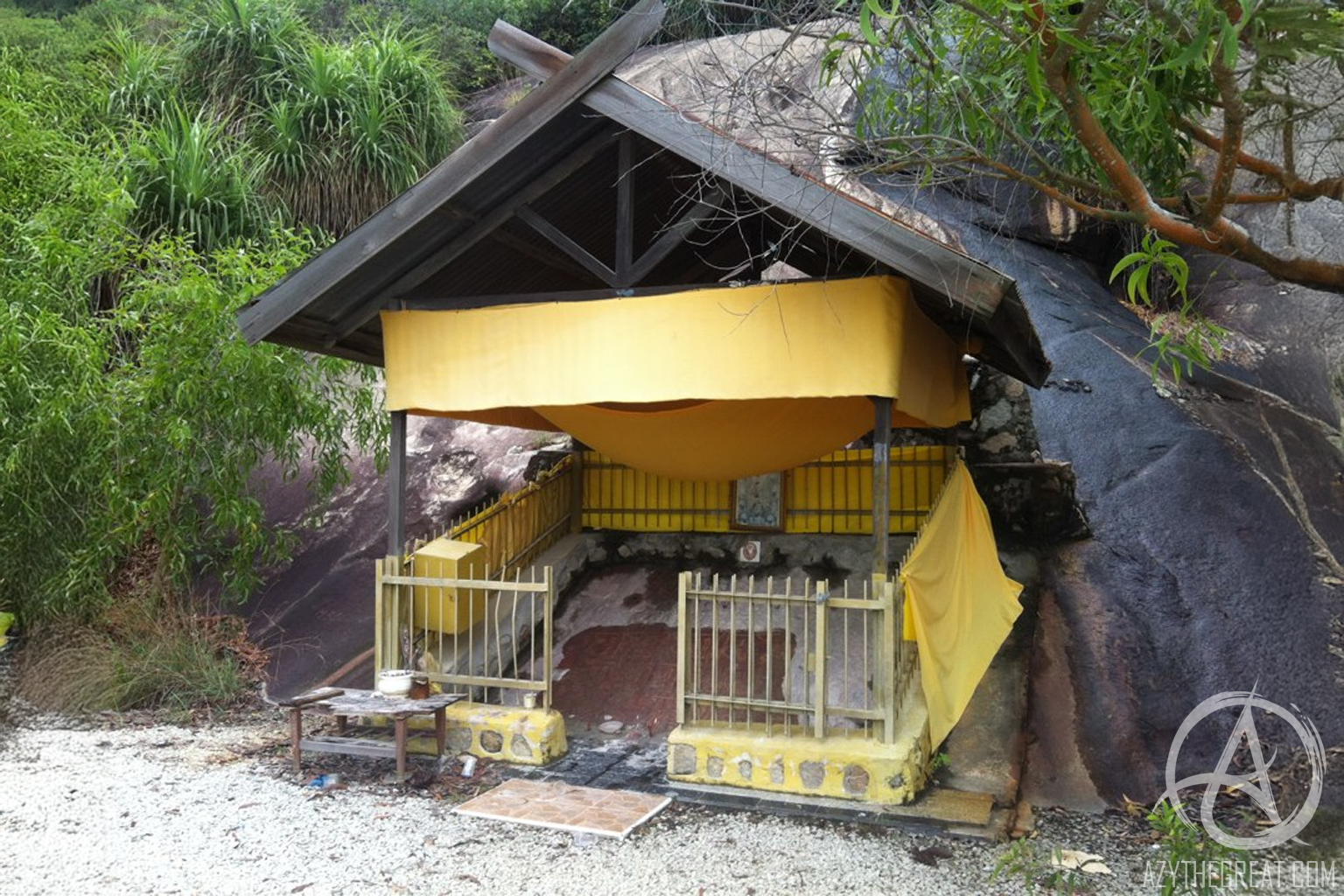
While I have yet to find evidence of a spring on Kusu, similar examples exist elsewhere, such as the Prasasti Pasir Panjang on Pulau Karimun Besar, a site that was once situated by the sea, according to locals. It features a water-filled rock formation resembling a natural well, suggesting that travellers may have stopped there in the past, with one eventually carving an inscription into the rocky surface. The inscription is now housed as a shrine, with both Hindus and Chinese attempting to assert dominance over it, despite it being located inside a granite quarry.
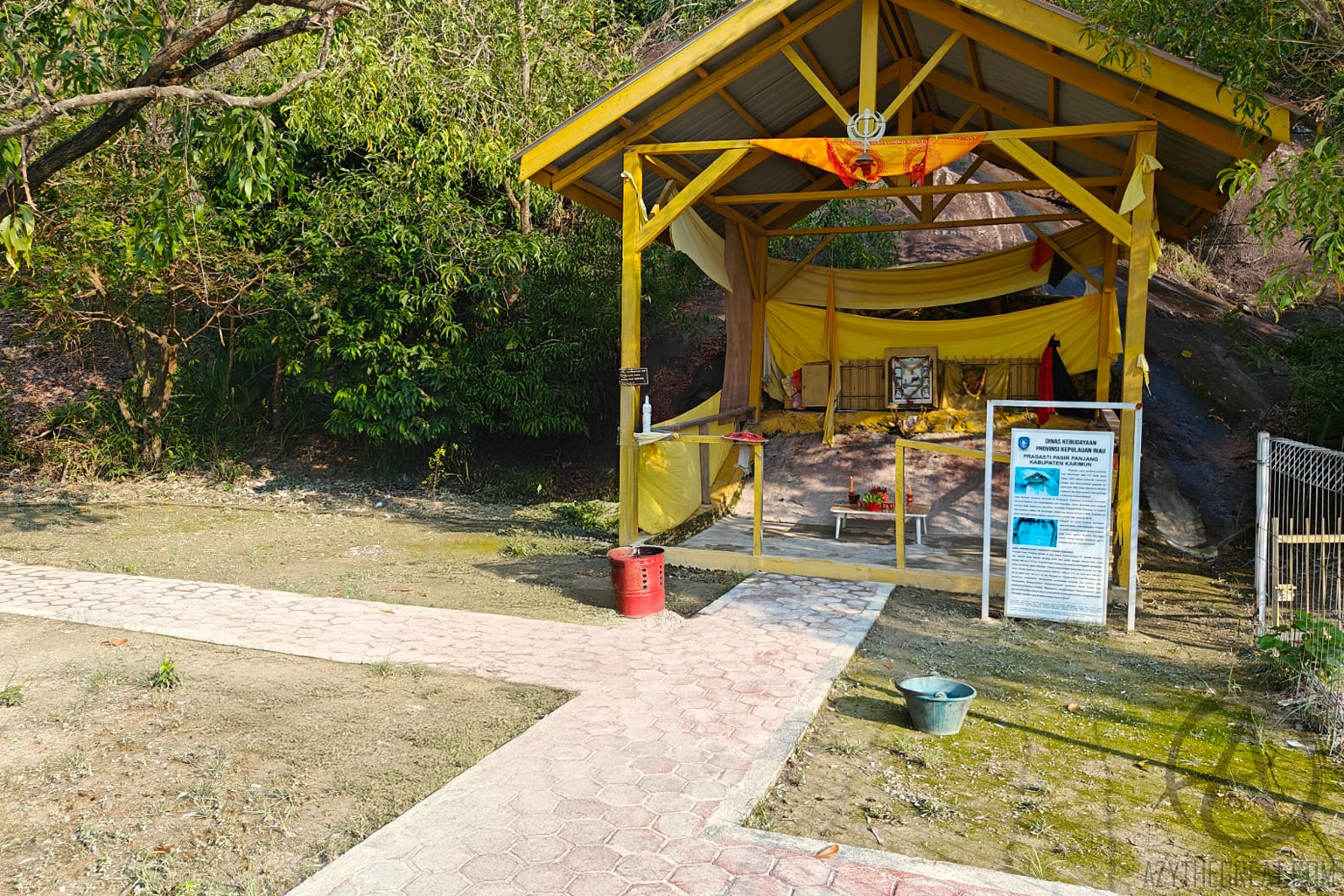
Alternatively, Kusu might have served an additional maritime purpose as a navigational aid for seafarers. Beyond its historical labels as Peak Island and Signal Island on old maps, and the presence of a white obelisk or harbour marker still standing today, however hidden, the light from the keramat on the hill, which could remain lit throughout the night13, would have turned the site into a makeshift lighthouse, warning passing vessels of nearby shallow waters and rocky outcrops.
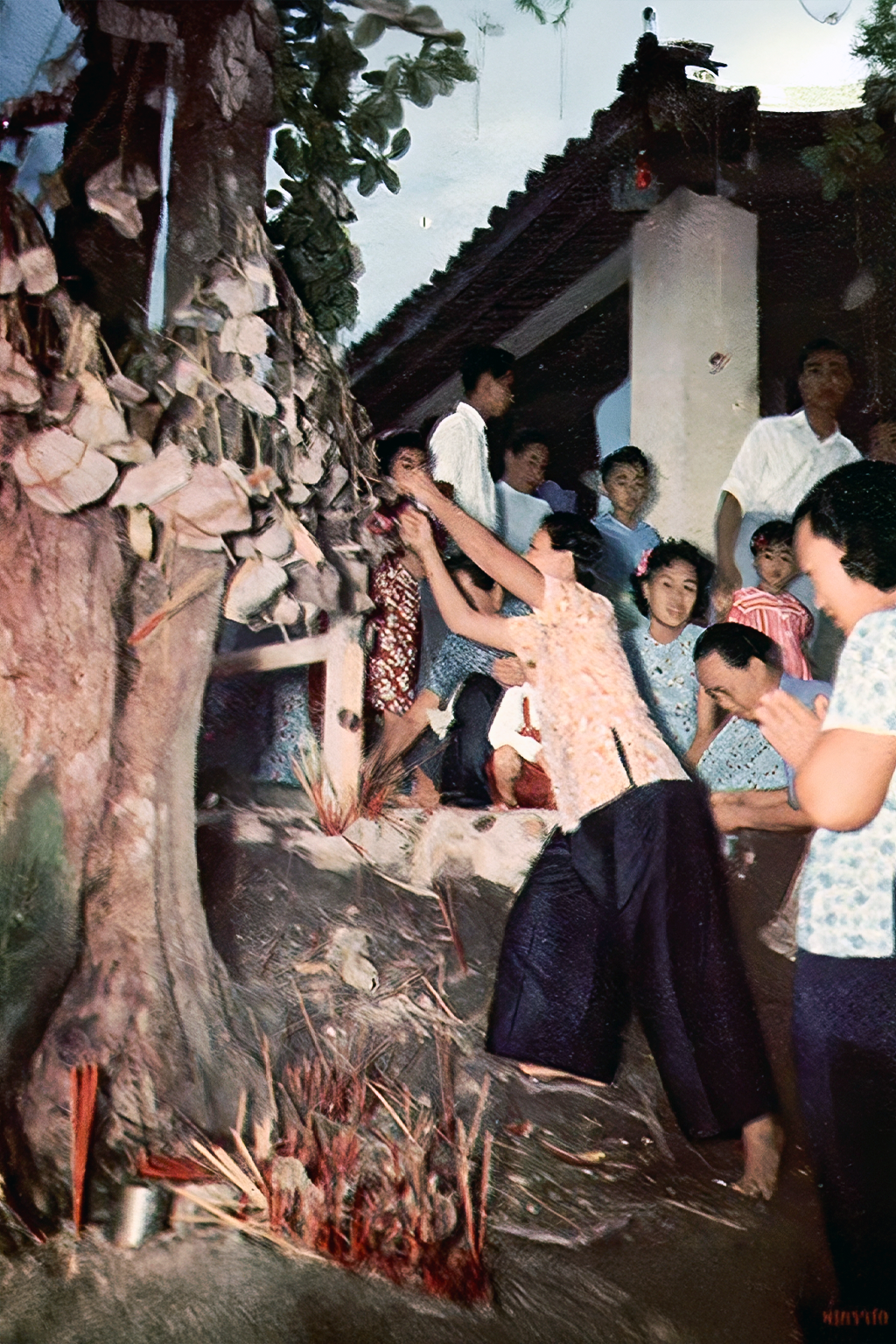
Source: NewspaperSG
Interestingly, yellow, like white, reflects light better than darker colours. Yellow being the predominant colour of Keramat Kusu today, is also commonly used in warning signs, high-visibility vests, and coastal markers because it stands out in both daylight and low light. Like white, it reflects light well, making both colours ideal for visibility in maritime settings. So was Keramat Kusu originally painted white? I don’t know, but the above photo seems to suggest so.
What does Kusu means?
The toponym Kusu originates from Hokkien, a Southern Min dialect spoken by early Chinese settlers in Singapore. In 1873, Douglas glossed ku as turtle or tortoise14, treating it as a general term for shelled reptiles. A decade later, Macgowan in 1883 glossed ku (龜) as tortoise and pih (鱉) as turtle15, likely referring to soft-shelled varieties. His precise differentiation of pih suggests that ku functioned as the primary term for hard-shelled reptiles in everyday Hokkien speech.
The second syllable, sū (嶼), corresponds to characters like 嶼, 島, or 洲, each meaning island or islet. 嶼 and 洲 are especially common in toponyms, and sū is the standard pronunciation in Pe̍h-ōe-jī. This structure follows established toponymic patterns in coastal Chinese regions. Examples include Xiaoliuqiu (小琉球嶼) and Daqiu Yu (大坵嶼) in Taiwan, Ap Chau (鴨洲) and Kat O Chau (吉澳洲) in Hong Kong, and Dongtou Yǔ (洞頭嶼) in Zhejiang. Each name pairs a descriptive root with an island suffix. In the case of Kusu, the descriptor is ku.
In essence, Kusu is Hokkien for Tortoise Island, a definition consistent with traditional toponymy, where the hill’s form resembles a tortoise’s humped shell, in contrast to the flat shell of turtles. It is also worth noting that the character 龟屿, featured in sources like Wikipedia16, is not of Hokkien but Simplified Mandarin, read as Guī Yǔ. In addition, various Singaporean source translated Kusu as Kusu Island, an unnecessary repetition akin to Bukit Timah Hill, Bukit Gombak Hill, and Bukit Batok Hill, where Malay Bukit already means hill. If Bukit Timah were subject to ongoing etymological layering, it would end up like Torpenhow Hill, a lexical stacking of the word hill in four languages. At least River Avon, where Avon is loaned from the Common Brittonic abona meaning river isnt that bad.
Reimagine the Legend of Kusu
An idea sparked in December 2013 to represent Kusu’s legend through the lens of maritime history. As my sketching skills were limited, I asked Hazwani if she was willing to do it. She agreed.
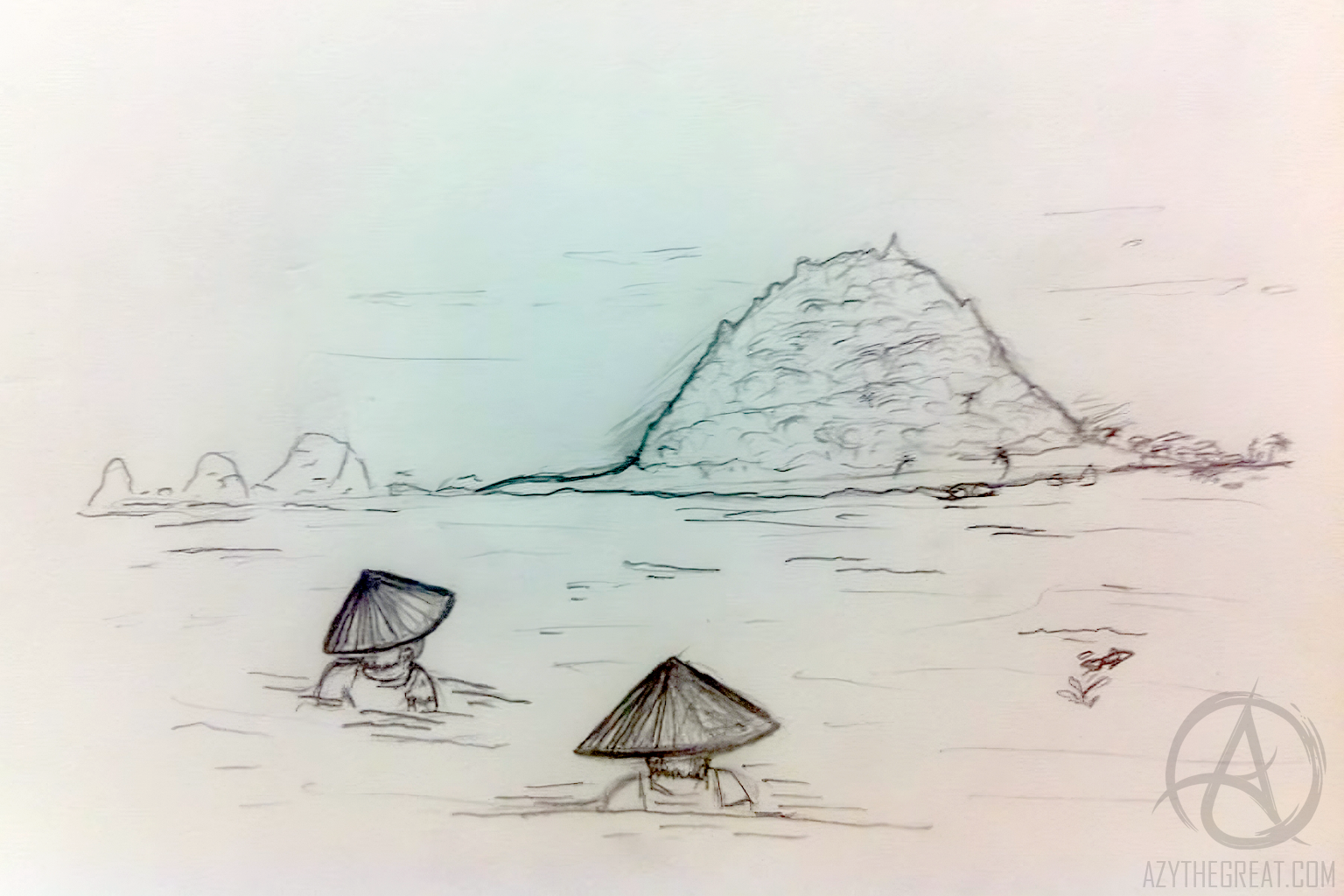
I sent her a photo of Kusu17, an image once apperared in Social Studies primary school textbook18, along with a rough sketch (above) combining both elements, then left the rest to her imagination. Two days later, on December 8, she emailed me her sketch.
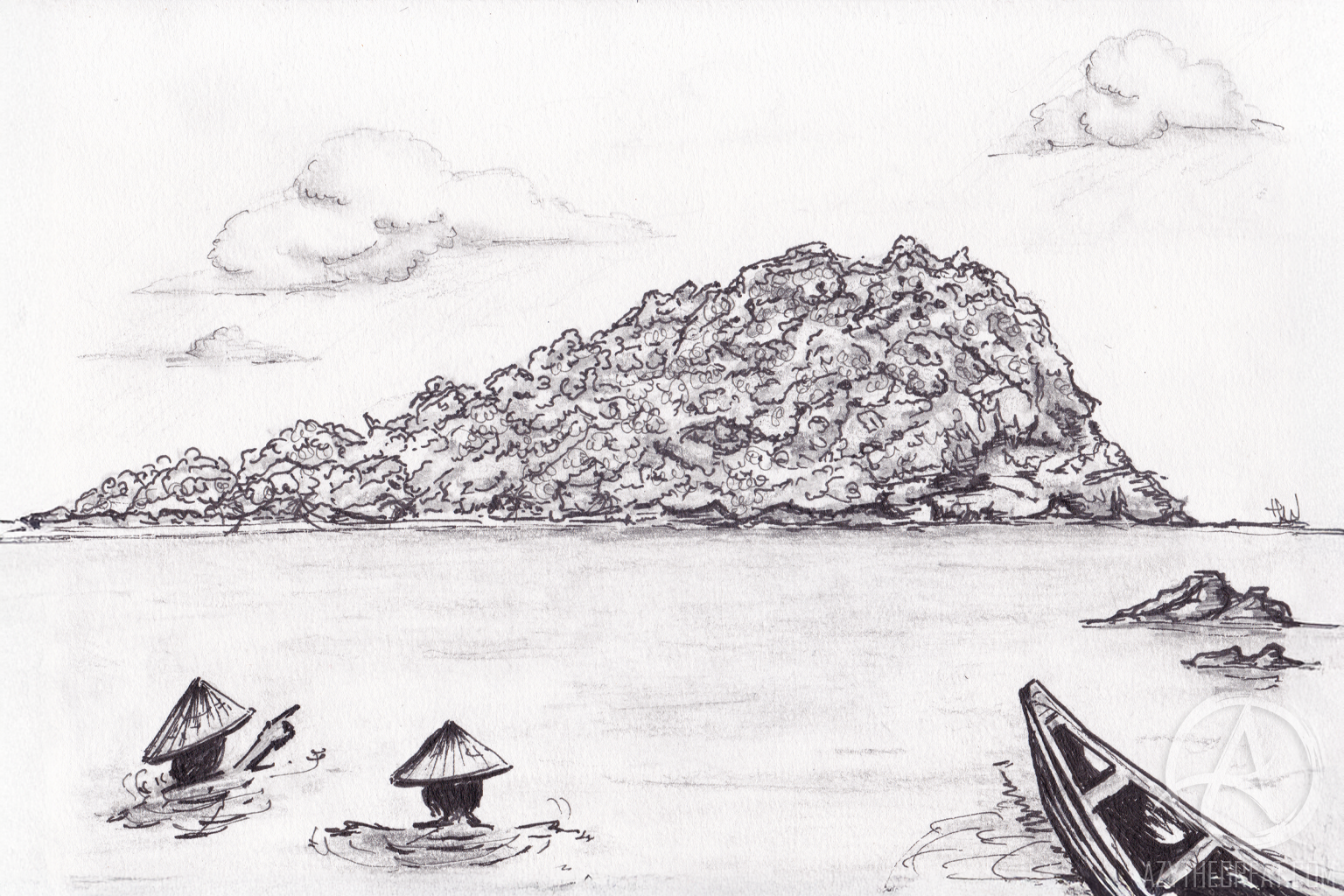
Her sketch looks good but sadly didn’t make it onto the Urban Explorers of Singapore Facebook page. Her other sketches did: Hillview Mansion’s entrance gate19, Turnhouse Sports Complex20 21, and a balconied building at Asrama Kerajaan Brunei di Singapura (AKBS)22.

Hazwani’s Kusu sketch had lain dormant in my inbox for over a decade, but with the recent release of Sora, I finally got a chance to repurpose her piece into this untangled, grounded view of the legend.
Hikari D. Azyure, an urban explorer based in Singapore since 1995, is an independent researcher who has collaborated with others across academic and private sectors. His research centres on etymology and toponyms that may or may not be tied to folklore and mythology within the intangible cultural heritage field.
That said, The Origin of the Legend of Kusu is an original work by Urban Explorers of Singapore. Please cite/mention “Urban Explorers of Singapore” as the source if any of this material is used.
- I was appointed as librarian at Qifa Primary School by Md Mastura in 1992. ↩︎
- The interchangeable use of tortoise and turtle across narratives reflects tension between preserving original phrasing and applying zoological accuracy since tortoises are non-aquatic yet overlooked the creature as imaginary. I use shelled reptile based on Carstairs Douglas’s 1873 definition, where Hokkien ku is a generic term encompassing both, reserving the specific form only when clarity is required. ↩︎
- The Pilgramage to Kusu Island, The Straits Times, 1 November 1929, p. 12 ↩︎
- Snake having chicken for a meal inside a cage at Bugis Street, National Archives of Singapore, 1978. ↩︎
- A snake in a cage at Sungei Road, National Archives of Singapore, 1980s. ↩︎
- Temple helper returning the snake to its cage at Kinta Road Temple, National Archives of Singapore, 1989. ↩︎
- Sit Yin Fong. Chinese Topics In Malaya, The Straits Times, 24 October 1932, p. 19. ↩︎
- Vernon Cornelius‑Takahama. Kusu Island, Singapore Infopedia, 10 September 2016 ↩︎
- Na Tuk Kong, Wikipedia. ↩︎
- Pulau Jong, Wikipedia. ↩︎
- The Forbidden Spring, Urban Explorers of Singapore, 14 September 2018. ↩︎
- Keramat Kusu, Wikipedia. ↩︎
- While overnight stays on Kusu have been prohibited since the late 1970s, the fire incident on April 2022 support this hypothesis. ↩︎
- Carstairs Douglas. Chinese-English dictionary of the vernacular or spoken language of Amoy : with the principal variations of the Chang-Chew and Chin-Chew dialects, 1873, p. 247. ↩︎
- John Macgowan. English and Chinese dictionary of the Amoy dialect, 1883, p. 540 & 549. ↩︎
- Kusu Island, Wikipedia. ↩︎
- Aika Augustine. Wisata Ziarah ke Pulau Kusu, KBR, 18 October 2013. ↩︎
- The legend of Kusu, Remembering Singapore, 25 June 25. ↩︎
- Hazwani Ismail. Hillview Mansion’s entrance gate, Urban Explorers of Singapore, 20 November 2013. ↩︎
- Hazwani Ismail. Turnhouse Sports Complex, Urban Explorers of Singapore, 6 December 2013. ↩︎
- Turnhouse Sports Complex, Urban Explorers of Singapore, 1 December 2013. ↩︎
- Hazwani Ismail. A balconied building at AKBS, Urban Explorers of Singapore, 18 January 2014. ↩︎
Comments are closed.